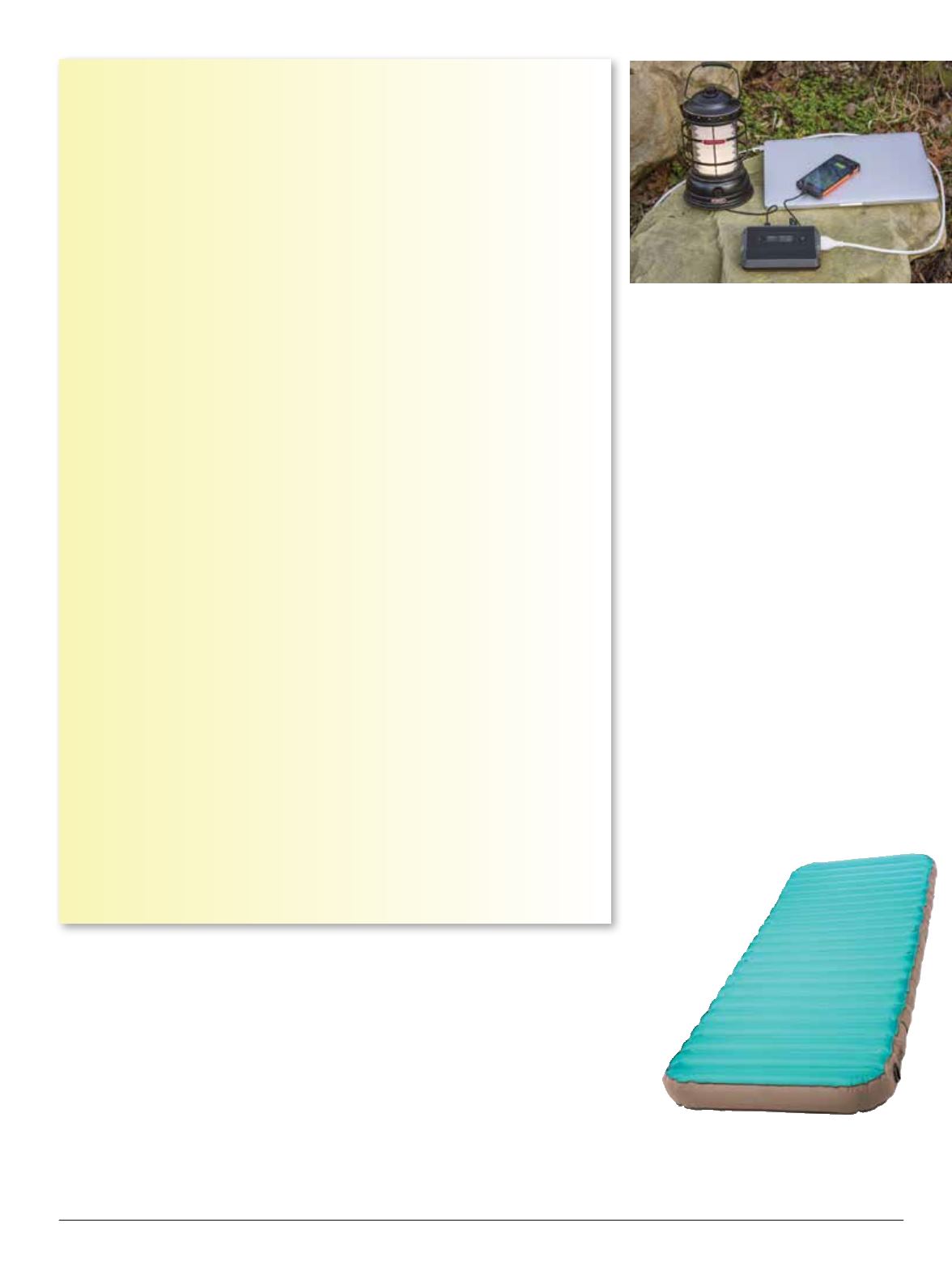

What’s more, according to a survey
by KOA, new campers in 2016 were
significantly more likely to spend their
nights in an RV than they were the
year before.
Design Impacts
Back within core outdoor spaces,
at least in terms of our camping gear
and done-in-day accoutrements,
there’s been something of a 180-de-
gree turn in design philosophy. For
the past several spring and summer
seasons, a whole lot of emphasis has
been placed on lowering weights.
From trail footwear to packs to tents
to sleep wares, we’ve seen ounces
shed and unnecessary bells and
whistles abandoned. Brands popped
up that were specifically built on the
premise of “fast and light;” we even
made it all the way to “ultralight.”
But when a wheeled and motorized
vehicle can take on the roles of backpack,
duffel bag and gear vestibule, all of sud-
den there is a lot more room in play with.
“Road tripping consumers want
gear that is compressible and easy to
transport but isn’t limited by the need to
fit in a 60-liter backpack,” says Greene.
“Instead, the added capacity of a car,
van or SUV at the campsite creates
an opportunity for products to strike
a better balance between packability,
versatility (to support a broad variety of
road life adventures) and livability (as
defined by comfort-focused features).”
“One of the things I’ve really en-
joyed about overlanding is worrying
less about every ounce you’re carrying
and focusing more on creating amaz-
ing meals and comfortable camping
experiences,” adds Brensinger.
Such sentiments may send shut-
ters down the backpack of outdoor
purists, but both Greene at Kelty and
Brensinger at NEMO are more inter-
ested in the upside.
“Designing for
vehicle-based
adventures is
fun because
there are less
constraints;
myCharge’s largest battery bank with the
highest power output, the AdventureUltra
is designed to replace the heavy and
bulky generators used when tailgating or
camping. myCharge says it can run a 42-
inch television for up to three hours. SRP
is $129.99.
Makes and Models
Buzzwords notwithstanding, vehicle-based adventures come in too many variations
to fit under any one moniker. Here’s what we see as the primary subcategories,
with some help from the editors at
Overland Journal
.
Car Campers
These folks are mostly found at developed campgrounds, often around fire pits
and picnic tables. The subcategory, however, also should include those who travel
further off the highway, likely setting up off of a forest road, and possibly near some
trails, rocks, rapids or lava tunnels. Car makers today have built versatile interiors
that attempt to mimic living spaces, making it appealing for car campers to use
their rides as shelters, power sources, beds and workspaces.
Backcountry Adventurers
Rather than a car, this group is using adventure motorcycles and four-wheelers
to get off the main roads for possibly several days with only the support of their
vehicles. Strap on a board, boat, bike or crash pad and these adventurers are able
to reach remote recreation spots that might otherwise be inaccessible to them.
Overland
The stricter definition, according to Overland Journal, is vehicle-supported, self-
reliant adventure travel, typically exploring remote locations and interacting with
other cultures. More generally, the spirit of exploration and life lessons of the
journey that are inherent to overlanding can also be found during a weekend trip
just 100 miles from home.
Further out on the longtail of overland are adventure travelers on organized,
vehicle-dependent expeditions, often involving long distances, varied terrains
and climates. The objective (and the customer) is not unlike that of the millions
of backpackers who have traveled the trails at home and abroad.
Vanlife
Also known as #vanlife, this is the stuff of Instagram dreams. In most cases, those
selfies could be of couples on an extended honeymoon, climbers chasing routes
near summer music festivals or a small family on a vacation road trip rolling from
geysers to amusement park to mountain hot spring. For the lucky few, it’s an
alternative way of life. Internet-connected and mobile-enabled, these vanlifers can
go
where the wind don’t blow so strange
and still function within the work world.
It’s not hard to understand the appeal.
“Van life is a new version of the American dream that’s more attainable and more
flexible than the big house in suburbia or the condo at the ski resort,” says Cam
Brensinger, NEMO founder and CEO, “Plus, North America has such an incredible
diversity of landscapes and local cultures, you can have a lifetime of experiences
on the road, bringing home with you everywhere you go.”
We’re sold.
The name says it all. Part of
Kelty’s mission to bring a piece of home
on the adventure, the
Tru.ComfortCamp
Bed can pair with a Kelty sleeping bag to
keep sleepers from rolling off the bed.
SUMMER
2017
|
Inside
Outdoor
29
















